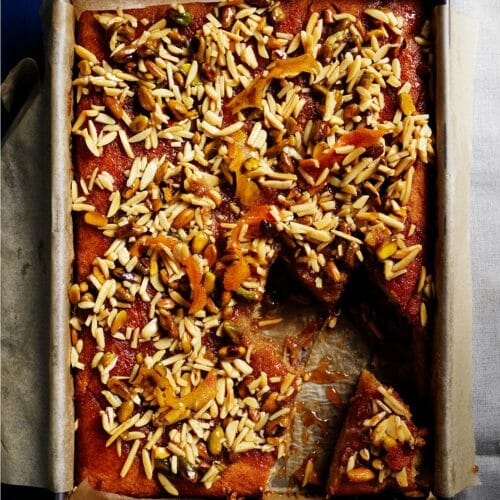
Queen Hera’s honey cake from The Joy of Better Cooking
Servings: 4
In Greek mythology, bees were the messengers of the gods, honey a source of wisdom and poetry, and saffron the blood of a fair and gentle youth. What this has to do with cake is dicey, but let’s go with the convenient notion that the Greek gods were also very into feasting, and this slab bake is perfect for sharing with a crowd. The batter’s robustness also means you can use even the strongest-flavoured honey — the kind that usually sits in the back of the cupboard after a few disappointed whiffs.
PRINT
Ingredients
- 250 g 9 oz unsalted butter softened
- 1 cup 220 g caster (superfine) sugar
- ¼ cup 90 g honey
- 1 tsp lemon zest
- 4 eggs
- 1 cup 150 g plain (all-purpose) flour
- 1 ½ cups 275 g fine semolina
- 1 ½ cups 150 g almond meal
- 5 tsp baking powder
- 2 tsp ground cinnamon
- 1 cup 250 g Greek-style yoghurt
Saffron nut syrup
- ½ cup 110 g caster (superfine) sugar
- ½ cup 175 g honey
- 50 g 1 ½ oz butter
- 3 strips of lemon zest plus the juice of 1 lemon
- 3 strips of orange zest plus the juice of 1 orange
- 1 tsp ground cinnamon
- 1 cup 125 g slivered almonds
- ½ cup 75 g shelled pistachio nuts
- a good pinch of saffron threads about 20 threads should do it
- a pinch of extra sugar
Instructions
- Preheat the oven to 175°C (340°F). Grease and line a baking tray measuring 25 x 33 cm (10 x 13 inches), and about 5 cm (2 inches) deep.
- Use a stand mixer, or a wooden spoon and plenty of arm action, to cream the butter, sugar and honey for about 10 minutes, until light and fluffy. Add the lemon zest, and then the eggs, one at a time, beating well after each addition and scraping down the side of the bowl.
- Sift the dry ingredients together twice, so they’re well mixed and aerated. Remove the bowl from the mixer. Dump in half the flour mixture and half the yoghurt and fold through with a flexible spatula. Add the remaining flour mixture and yoghurt and stir until well mixed. Mealy mixtures always yield a stiffer batter, so nothing to worry about here.
- Spoon the batter into the tray and flatten down right to the edges, using an offset spatula (see Tips, page 268). Bake for 30 minutes, or until golden.
- Meanwhile, make the syrup. Place the sugar, honey, butter, citrus zest and juice, cinnamon, nuts and ½ cup (125 ml) water in a saucepan. Bring to the boil, then leave to reduce by one-third. Meanwhile, grind the saffron with an extra pinch of sugar using a mortar and pestle, or the back of a teaspoon and a little bowl. Pour 2 tablespoons warm water over the top. Take the reduced syrup off the heat, stir the bloomed saffron through and set aside.
- While the cake is still hot, use a sharp knife to cut it into diamonds or squares, à la baklava, to the size of your choice. Pour the saffron nut syrup over, spreading the nuts evenly and removing the citrus strips.
- Return to the oven with the top element on to burnish the nuts; this should only take 5–10 minutes. Keep an eye on it, so those delicate nuts don’t burn.
- The cake will keep for 4–5 days in an airtight container at room temperature.
Notes
Recipe riffs
• Orange + almond: Halve the yoghurt. Boil an orange until tender, then blitz and fold into the batter. Go heavier on the orange zest in the syrup.
• Fennel + lemon: Add 1 tablespoon fennel seeds to the batter. Swap the saffron with 1 teaspoon vanilla bean paste and the zest of 1 lemon.
• Almond + coconut: Stir 1/3 cup (30 g) desiccated